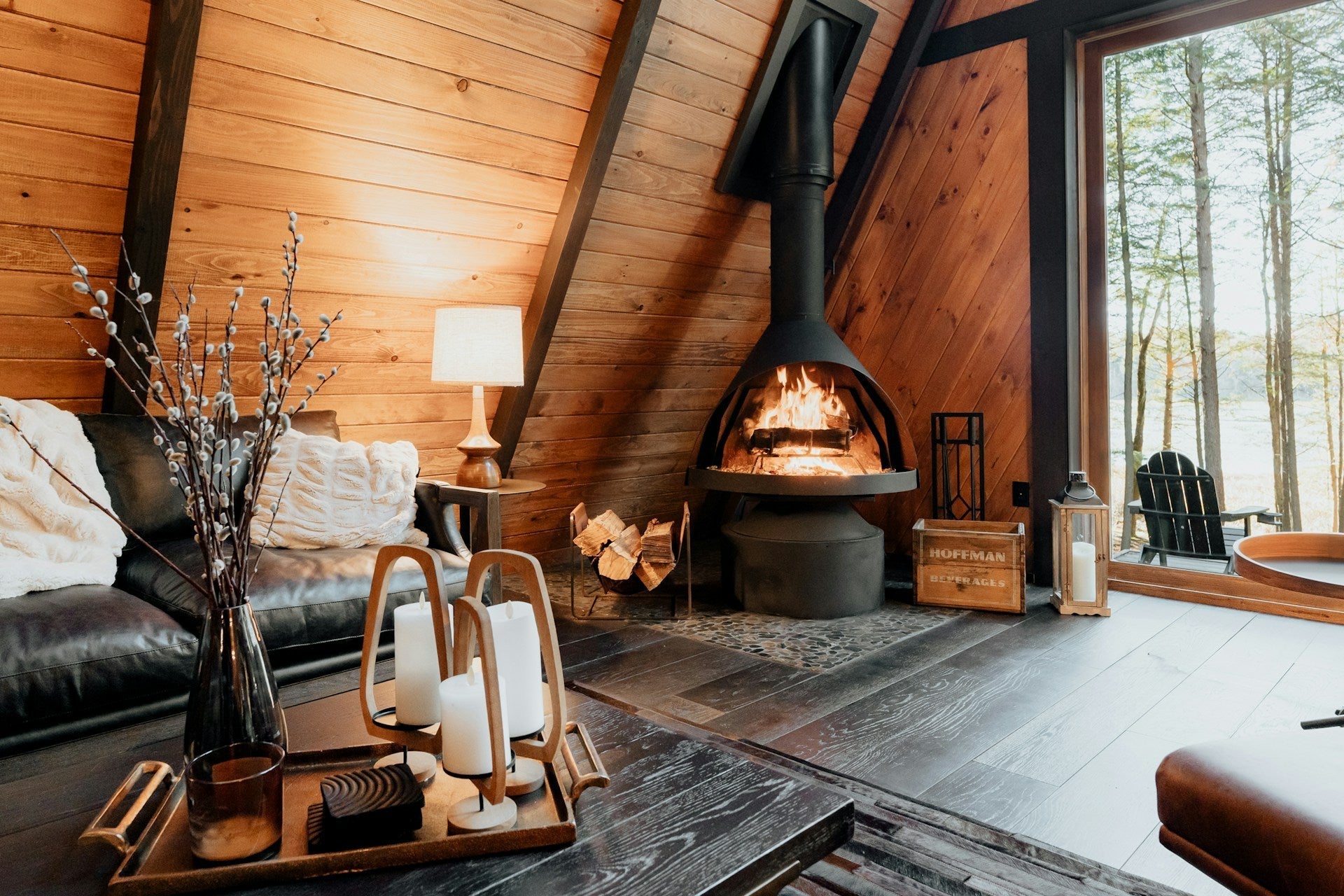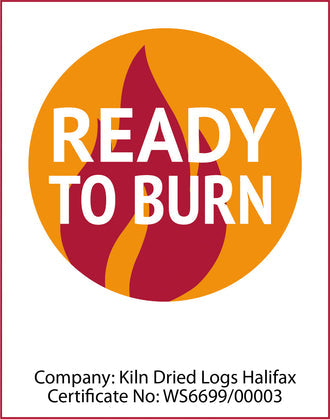
Does Burning Wood Produce Carbon Monoxide in Fireplaces and Stoves?
The question "does burning wood produce carbon monoxide" reflects growing awareness among homeowners about wood-burning appliance safety. As more people turn to wood heating for economic and environmental reasons, understanding potential risks becomes essential. This concern is well-founded – carbon monoxide (CO) poisoning from heating appliances causes hundreds of deaths annually in the UK, according to the Health and Safety Executive (HSE).

Modern homes present unique challenges that make carbon monoxide safety more complex. Better-sealed buildings can trap dangerous gases if proper ventilation isn't maintained, while fuel quality significantly impacts both safety and efficiency. Understanding the relationship between wood combustion and carbon monoxide production empowers homeowners to enjoy wood fires while maintaining the highest safety standards.
What Happens When Wood Burns: The Science of Combustion
Wood combustion converts wood and oxygen into heat, carbon dioxide, and water vapor under ideal conditions. However, real-world burning rarely achieves perfect combustion, leading to various byproducts including carbon monoxide.
Complete combustion occurs when wood burns at sufficiently high temperatures with adequate oxygen supply. Carbon atoms combine with two oxygen atoms to form carbon dioxide (CO2), while hydrogen creates water vapor (H2O). This releases maximum energy while producing relatively harmless byproducts.
Incomplete combustion happens when burning conditions are suboptimal – typically due to insufficient oxygen, low temperatures, or poor fuel quality. Carbon atoms combine with only one oxygen atom, forming dangerous carbon monoxide (CO) instead of carbon dioxide. This process releases less energy while creating an odorless gas that can accumulate dangerously in enclosed spaces.
Fuel moisture content significantly impacts combustion quality. Wet or unseasoned wood requires substantial energy to evaporate water before effective combustion can occur, leading to lower burning temperatures and incomplete combustion. Properly dried wood, particularly kiln dried logs with moisture content below 20%, burns more efficiently and produces fewer harmful emissions than green or inadequately seasoned alternatives.

Does Burning Wood Produce Carbon Monoxide? The Direct Answer
Yes, burning wood does produce carbon monoxide under certain conditions, but the amount and risk depend significantly on combustion quality, equipment condition, and fuel characteristics. All organic fuel combustion has potential to produce carbon monoxide when burning conditions are inadequate.
However, properly managed wood burning in well-maintained appliances with appropriate fuel typically produces minimal carbon monoxide levels that pose little risk when adequate ventilation is maintained.
Primary conditions that increase carbon monoxide production include:
-
Poor ventilation restricting oxygen supply for complete combustion
-
Blocked or damaged chimneys preventing proper exhaust gas removal
-
Using unseasoned, wet, or poor-quality wood creating suboptimal burning conditions
-
Improperly maintained appliances not achieving necessary temperatures
-
Incorrect operation techniques affecting combustion efficiency
The distinction between outdoor and indoor air quality is crucial. While some carbon monoxide production is normal during combustion, proper chimney draft and ventilation should carry gases safely outside. Problems arise when this system fails due to blockages, damage, or inadequate maintenance.
Modern wood-burning appliances, when properly installed and maintained, minimize carbon monoxide production through improved combustion efficiency and reliable exhaust systems. However, these safety features depend on correct installation, regular maintenance, and appropriate fuel selection.
Wood-Burning Stoves and Fireplaces: Risks and Safe Operation
Wood-burning stoves and fireplaces operate on controlled combustion within a firebox, with exhaust gases drawn through a chimney system. Understanding this system helps identify potential failure points that could lead to carbon monoxide issues.
Traditional open fireplaces draw combustion air directly from rooms, creating updraft that carries exhaust gases up chimneys. While effective when functioning correctly, this design can be problematic if the chimney system is compromised. Wood-burning stoves feature controlled air intake systems and enclosed fireboxes promoting more complete combustion, generally producing less carbon monoxide than open fireplaces.
Carbon monoxide wood burning stove issues typically arise from system malfunctions rather than normal operation. Blocked chimneys from debris or creosote buildup can restrict exhaust flow and cause dangerous backdrafting. Cracked chimney liners or damaged stove pipes may allow exhaust gases to leak into homes before reaching outside.
Proper installation and regular professional inspections help identify and correct these issues before they become dangerous. User behavior also influences risk – closing dampers too quickly or burning inappropriate materials can create conditions increasing emissions or preventing proper exhaust removal.
Health Risks of Carbon Monoxide: The Silent Killer
Carbon monoxide poses serious health risks by interfering with blood's oxygen-carrying ability. This colorless, odorless gas binds to hemoglobin approximately 200 times more readily than oxygen, effectively starving body tissues of necessary oxygen.
The World Health Organization identifies carbon monoxide poisoning as one of the most common types of fatal air poisoning worldwide, with wood-burning appliances representing a significant residential exposure source.
Early carbon monoxide exposure symptoms include:
-
Persistent or unusual headaches
-
Unexplained dizziness or lightheadedness
-
Nausea without apparent cause
-
Unusual fatigue or weakness
-
Shortness of breath during normal activities
-
Confusion or difficulty concentrating
Severe poisoning symptoms include:
-
Severe headaches and persistent vomiting
-
Mental confusion or disorientation
-
Loss of consciousness or fainting
-
Chest pain or rapid heartbeat
-
Vision problems
-
Loss of muscle coordination
The EPA emphasizes that even moderate carbon monoxide levels can cause permanent health effects, making prevention absolutely critical. Children, elderly individuals, and people with existing health conditions face higher risks and may experience symptoms more quickly than healthy adults.
Prevention and Safety Measures: Protecting Your Home and Family
Preventing carbon monoxide problems requires comprehensive approach addressing fuel quality, equipment maintenance, ventilation, and monitoring.
Fuel selection plays a fundamental role in prevention. Using properly seasoned wood with moisture content below 20% promotes complete combustion and reduces harmful emissions. Kiln dried logs represent the gold standard for safe wood burning, as controlled drying ensures consistent low moisture content supporting efficient, clean combustion. These logs ignite more easily, burn at higher temperatures, and produce significantly less smoke and carbon monoxide than inadequately seasoned alternatives. Premium quality options are available in our Kiln Dried Logs Collection, specifically processed to meet the highest safety standards.
Essential safety practices include:
-
Annual professional chimney inspections and cleaning
-
Regular checking of chimney caps and connections for damage
-
Installing carbon monoxide detectors on every level, especially near sleeping areas
-
Ensuring adequate fresh air supply for combustion
-
Using only properly seasoned or kiln dried wood
-
Never burning trash, painted wood, or treated lumber
-
Keeping dampers fully open during operation
Carbon monoxide detectors provide crucial early warning and should be installed according to manufacturer recommendations. Choose detectors with digital displays showing CO levels, not just alarms. Regular testing and battery replacement ensure reliable operation.
Professional installation and maintenance cannot be overstated. Certified technicians understand complex interactions between appliances, chimney systems, and home ventilation affecting safety.

Environmental Impact and Efficiency
Wood burning can be carbon-neutral when practiced sustainably, but environmental impact varies based on fuel processing and combustion efficiency. The EPA demonstrates that modern appliances with appropriate fuel produce significantly lower emissions than older equipment, benefiting both air quality and safety.
Kiln drying requires energy input but produces fuel that burns more cleanly and efficiently than air-dried alternatives. This controlled moisture content enables more complete combustion, reducing both carbon emissions per heat unit and harmful byproduct formation, including carbon monoxide.
Frequently Asked Questions
Does wood burning produce carbon monoxide indoors?
Wood burning shouldn't produce significant indoor carbon monoxide when appliances are properly installed, maintained, and operated with appropriate fuel. Problems typically result from equipment malfunctions, poor maintenance, or using wet/poor quality wood.
Can a wood burning stove cause carbon monoxide poisoning?
Yes, if not properly installed, maintained, or operated. Common causes include blocked chimneys, damaged flue systems, or inappropriate fuel. Properly functioning stoves with regular maintenance present minimal risk.
Is burning kiln dried wood safer?
Yes, kiln dried wood is generally safer than inadequately seasoned firewood. Low moisture content promotes complete combustion, reducing carbon monoxide and other harmful emissions while providing cleaner, more efficient burning.
What should I do if my CO detector alarms?
Immediately evacuate all occupants to fresh air and call emergency services. Don't re-enter until the building is ventilated and CO source identified and corrected by professionals.
Conclusion: Safe Wood Burning for Your Home
Understanding the relationship between wood burning and carbon monoxide enables safe enjoyment of wood heating benefits. While all combustion can produce CO, proper equipment, maintenance, and fuel selection minimize risks to acceptable levels.
Safe wood burning rests on quality equipment properly maintained, appropriate fuel supporting clean combustion, and adequate ventilation with reliable monitoring. Kiln dried logs offer superior safety performance compared to inadequately seasoned alternatives, providing low moisture content necessary for clean combustion that minimizes harmful emissions.
Regular professional maintenance and carbon monoxide detection create comprehensive household protection. Environmental benefits of responsible wood burning align with safety considerations – practices reducing environmental impact also produce safer operation.
Choose Premium Kiln Dried Logs for Safer Heating
Ready to enjoy safer, cleaner wood burning? Fuel quality plays a crucial role in both safety and efficiency, making proper wood selection essential for responsible heating.
Explore our Kiln Dried Logs Collection for premium logs supporting the cleanest, safest burning possible. Our kiln dried logs undergo controlled processing to achieve optimal moisture content, ensuring efficient combustion that minimizes carbon monoxide production while maximizing safety and heat output.
Invest in quality fuel that prioritizes your family's safety while delivering superior heating performance. Choose kiln dried logs for the peace of mind that comes from fuel specifically processed to meet the highest safety and efficiency standards.
Share
